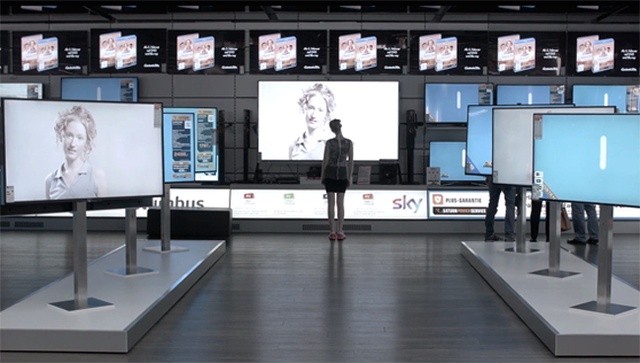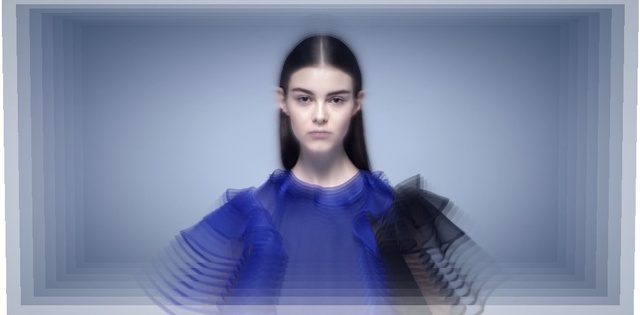Do Media Determine our Situation? Reflections on the transatlantic reception of Friedrich Kittler by Isabelle Graw, Reinhold Martin, and André Rottmann
Though often spoken, “German media studies” is conclusively a misnomer, what with all of the disparate notions within German media discourse of what media are. If one is nevertheless to employ the term, the work of Friedrich Kittler quickly arises. And indeed to say his name is to invoke a theory of media that is both institutionally entrenched and contentious, a debate that runs deep in arts theory as much as in the pages of Texte zur Kunst.
But arriving in the American academy, in the late 1980s and more fully in translation in the decades that followed, the work of Kittler and of those who developed it further and/or proposed alternatives was metabolized differently. By the ’00s, “German media studies” appeared to some participating primarily in English-speaking discourse as a new framework for redefining the scope of such seemingly static theoretical lenses as post-Marxism and Institutional Critique. In turn, this inspired new readings of the constitutive material in Germany, too.
In this issue, we have called on Isabelle Graw (co-founder of this journal), Reinhold Martin (co-founder of Grey Room), and André Rottmann (former editor-in-chief of Texte zur Kunst), to share their thoughts as editorial voices, on either side of the Atlantic, that have sounded in various ways in this debate: Here, Graw speaks to Texte zur Kunst’s ostensible position against Kittlerian thought or rather the journal’s own understanding of how media and the social intersect; Rottmann elaborates, giving further context to related media theorists; while finally, Martin speaks of the arrival of this conversation in the US.
Reinhold Martin
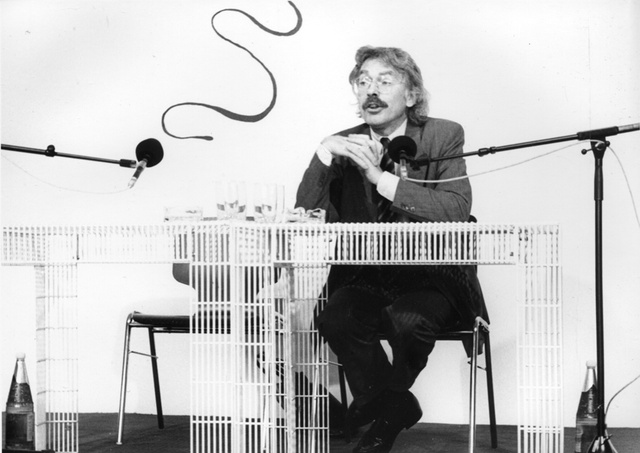 Friedrich Kittler lecturing in Graz on the occasion of Steirischer Herbst "Chaos und Ordnung" (Chaos and Order), 1989
Friedrich Kittler lecturing in Graz on the occasion of Steirischer Herbst "Chaos und Ordnung" (Chaos and Order), 1989
Texte zur Kunst: The reception of Friedrich Kittler and German media theorists has been very different in the American academy than in the German academy. As one of the scholars who has informed Kittler’s legacy in America, could you give your perspective on this American reception? Also, since Columbia University has had a distinct relationship to this reception in comparison to other American universities, perhaps you could comment on that as well.
Reinhold Martin: The American reception of Kittler’s work probably began in earnest with the translation of “Aufschreibesysteme” (1985) as “Discourse Networks” in 1990. I encountered that text and others as a PhD student at Princeton in the mid-90s, not in the School of Architecture (where I was studying) but through faculty in the humanities. Shortly after arriving at Columbia in 1997 while still completing my PhD dissertation, I was pleasantly surprised to find that Kittler was a visiting professor in the Department of Germanic Languages, having been invited by Harro Müller. I introduced myself, and he was perhaps equally surprised to find someone in architecture interested in his work. We met a few times while he was in New York (I remember a particularly lively discussion about “computer architecture”), and it was amusing to occasionally run into Kittler working among the architecture and art history students in Avery Library. At Columbia more generally, there have long been scholars involved with various forms of media theory, related especially to the Frankfurt School or Situationism, in relation to (or against) which Kittler’s work can be and was read. Not only people like Andreas Huyssen or Jonathan Crary, but also Dorothea von Mücke, who translated the introduction to “Gramophone, Film, Typewriter” that was published in October in 1987.
Arguably, it was “Gramophone, Film, Typewriter” (translated in full in 1999) that most decisively shaped the American reception of Kittler. And it is this book’s polemical opening sentence – “Media determine our situation” – that has probably done more than anything to skew the American discussion of media theory toward the question of technological determinism. Personally, I regard this as a relatively minor question, an overly simple narrative (which could be rephrased in my own field as “steel determines our situation,” etc.). Nevertheless, I do take very seriously Kittler’s posthumanism: his frequent reference to “so-called man,” which, from “Discourse Networks” onward, essentially translates the famous image at the end of Michel Foucault’s “The Order of Things” – of a face drawn in the sand disappearing at the water’s edge – out of the realm of language and into the realm of things. In that sense, I have always read Kittler most directly in relation to Foucault.
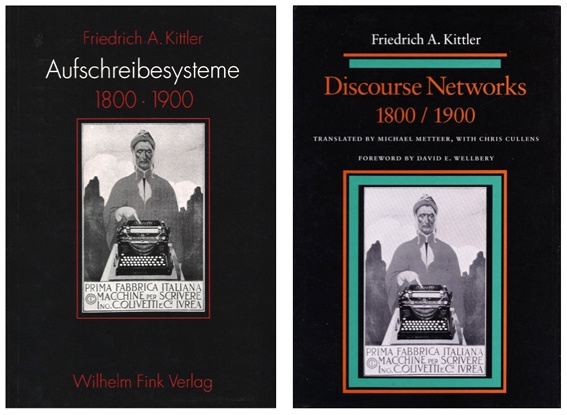
But to what extent does a “writing-down system” circa 1800 or 1900 actually resemble a Foucauldian dispositif? Insofar as it involves social and cultural training and interacts with other historical processes like industrialization, I would say that the connection is quite close. There are, however, important differences, not the least of which is Kittler’s deliberate avoidance of Marx or Marxism, which should be distinguished from Foucault’s circumspection. There is also the question of the archive, which in Kittler’s work generally remains limited to technical media as such, rather than technological systems, infrastructures, or other biopolitical regimes. The “cultural techniques” hypothesis has significantly expanded the archive of media theory (I am thinking, for example, of Bernhard Siegert’s work on doors, textiles, ships, and other “techniques”). Nevertheless – and maybe this is a function of my architectural point of departure – I approach the question differently, by asking: what does media theory help to explain about the social and historical field that other approaches do not?
This amounts to doing history with media, rather than doing media history as such. At Columbia, some of these issues were discussed at a 2011 conference on this subject organized by Stefan Andriopolous, Brian Larkin, and myself in collaboration with colleagues from Princeton and Weimar. We continue to discuss these and other issues in a variety of forums, without any real consensus, I must say, as to limit conditions or absolute boundaries. In my view, the matter has less to do with the reception of a particular theoretical discourse than with the remediation of that discourse within an infrastructure – the interdisciplinary humanities in the research university – that combines discourses into impure admixtures.
TZK: In Grey Room, which you co-founded in 2000, the work of Kittler has not only been integrated into interdisciplinary discussions of both art and architecture, but has formed part of a discursive nexus that has also included the reception of Autonomia, Feminism, and Foucault’s discussions of biopolitics. As the latter have largely been institutionalized as conflicting with Kittlerian media theory, where would you situate his politics within this constellation?
Martin: Last year I taught a graduate seminar at Columbia on “Architectural Infrastructures and Cultural Techniques,” in which we read Kittler as well as authors related to the Kulturtechniken hypothesis (Cornelia Vismann and Siegert, for example) alongside recent architectural scholarship on infrastructure and technical systems. Variations on this question came up frequently. I would say that Vismann’s work on filing systems and the law provides one cogent answer; Siegert’s work contains indirect reflections on governmentality; and Joseph Vogl has offered a media-theoretical critique of capital. In relation to the other theories you mention, it is sometimes said that Americans came to this material not only in translation but also belatedly – often engaging, for the first time in the ’90s, ideas that European thought had dispensed with in the ’70s. And so some argue that theoretically-oriented political debates centered in the American academy are anachronistic. I find this unconvincing, especially if taking a post-Kittlerian approach that challenges both epochal and progressive models of history. Untimeliness can be productive. In fact, certain historiographical questions raised by the “cultural techniques” approach, including an emphasis on thresholds or transitions rather than on breaks, point toward some of the most difficult political questions of our time. Is not the problem, after all, one of accounting for how things change?
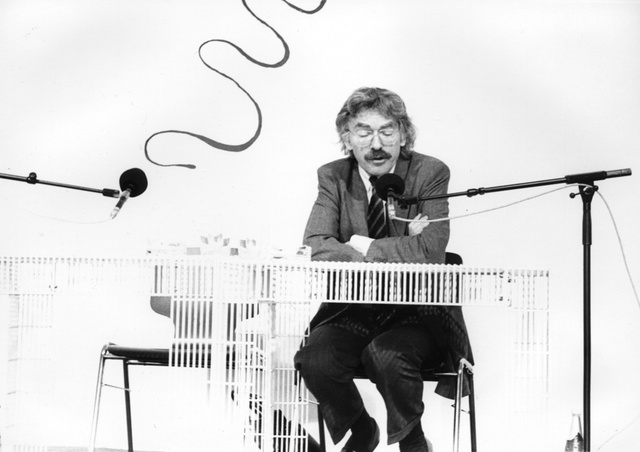 Friedrich Kittler, Graz, 1989
Friedrich Kittler, Graz, 1989
Although I wouldn’t overestimate editorial intent, Grey Room may have helped shift the archive of modernist studies forward, toward the “postwar” (and to a lesser extent, postcolonial) period. But the historiographical questions we sought to pose were partly oriented toward the concomitant possibility of an epochal transition into what Deleuze called a “control society,” even as we sought to examine the epistemic conditions under which such a shift would be intelligible in the first place. Kittler often emphasized the acceleration of technological development during the Second World War. We may have tacitly endorsed this, and with it, a shift in the center of gravity, in architectural studies at least, away from the 1920s and 1930s and toward the 1950s and 1960s. Along with this shift came new political questions, which in Europe and in the United States were summarized by the year 1968, in the aftermath of which many of the theories you mention emerged. But as a historian, I remain convinced that, despite his overstatement of epochal shifts, the changes Kittler recognized during the nineteenth century and analyzed in “Discourse Networks” and “Gramophone, Film, Typewriter” were equally if not more important.
In terms of transatlantic exchange, credit goes (as mentioned earlier) to October for first translating the introduction to “Gramophone, Film, Typewriter.” Still, Kittler was a founding board member of Grey Room and we translated and published two of his essays. Like other board members, he would also occasionally refer students or colleagues to us. From the start, we have not, as a journal, aimed for synthesis or a party line. Speaking for myself, I don’t read everything for its political content; I read first for knowledge, since without that, any serious political project is lost – or worse. That said, politics, by and large, remains among media theory’s blind spots. I would therefore suggest that, rather than superimposing this theory onto others with which it shares little, we reflect critically on a politics that is immanent to media. We could call this a “mediapolitics,” to complement Foucault’s “biopolitics.” Work along these lines can certainly be put into more direct conversation with other materialisms, including Marxian ones.
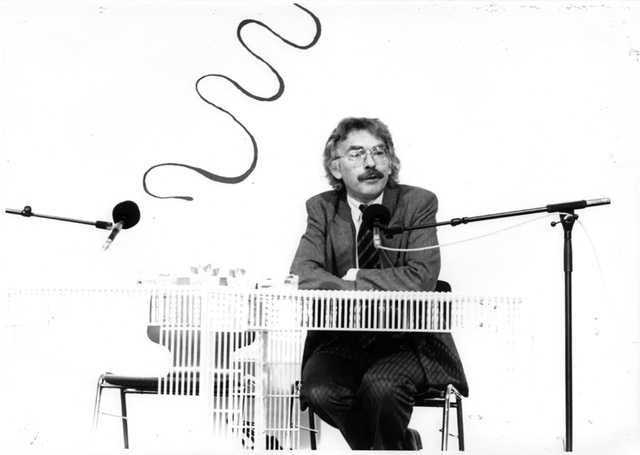 Friedrich Kittler, Graz, 1989
Friedrich Kittler, Graz, 1989
TZK: Starting with your writing on corporate architecture, you have approached architecture and institutions in a way that extends or redirects certain aspects of Kittler’s work. With your current focus on the history of the university, how do you consider the reorganization of not only the university, but also pedagogy and education in general?
Martin: I define the modern research university, which dates back to what Kittler called the “discourse network of 1800,” as a media system rather than as an institution. In general, I am concerned more with intermedial relations internal to it, rather than with studying individual media and their effects in isolation. For example, in pedagogy as in knowledge-making, relations between speaking and listening and between reading and writing change over time. My aim is to describe the university as an incomplete system of linkages, translations, offsets, and delays through which such changes occur. Put slightly differently, this amounts to doing history with architecture, understood as one among many media into which, paradoxically, other media are enfolded, rather than writing a history of architecture. It also entails breaking architecture down into unresolved fragments, bits and pieces of hardware that assemble in different ways and produce knowledge differently.
You could also call this approach infrastructural, if you do not assume infrastructure to refer to a fully integrated system. Though this work centers on the late-eighteenth and early-nineteenth centuries, and thus its archive largely predates that which is addressed in my earlier work on corporate architecture, I consider it an advance on that work, in that it treats something closer to reality: partial objects, incomplete things, rather than fully (and ideologically) constituted totalities. Out of these fragments, I aim to derive the basics of an “architecture of knowledge” that explains the power-knowledge structures of what we offhandedly call intellectual work, the basis of a “knowledge economy.” An interesting task is thus identifying the relevant pieces within of a seemingly endless pile of semi-obsolete, provisionally assembled hardware. That means discarding received ideas like “type,” wherein there is a spatial type called a campus, and an architectural type called an academic building or space, like a library or classroom. The task, instead, is to break specific buildings and spaces open, to look inside the walls as well as between them, in order to reconstruct elements of the power-knowledge complex and its genealogies.
 Dining Room of Thomas Jefferson, Monticello, Virginia
Dining Room of Thomas Jefferson, Monticello, Virginia
Take, for instance, the dumbwaiters that Thomas Jefferson, a bibliophile and founder of the University of Virginia, installed in the dining room in Monticello, the residence he designed for himself near Charlottesville, Virginia. Upstairs, the dining room belonged to the archetypal bourgeois public sphere, a salon (though not exactly the Berlin coffeehouses celebrated by Habermas!) in which Jefferson and his distinguished white guests would discuss urgent intellectual and political matters, sipping French wine. Immediately below was the wine cellar. The dumbwaiters were mechanisms that connected the two spaces, so that black slaves, below, would be able to send wine up as needed without having to enter the dining room. You could therefore say that, in this case, the “republic of letters” was produced by the double silence of the slaves, who were prevented from overhearing the important discussions going on upstairs, as well as from interrupting them with their speech. As a mechanism for “purifying” the dining room and maintaining – through its repetitions – a stable distinction between what was spoken and heard upstairs and what was spoken and heard downstairs, the dumbwaiter was an infrastructural, mediapolitical device, like the chain that binds lord and bondsman in Hegel’s “master/slave” dialectic.
TZK: How would you define the term “infrastructure”? Does the discourse of cultural techniques help us to understand its operations? And how does it relate to our understanding of the “media history of the social”?
Martin: Infrastructure is what repeats. The dumbwaiter, bound to slave labor, carries bottle after bottle up to Jefferson’s dining room. Its systemic properties tend to become visible only when the repetitions cease. If the wine ceases to appear, at some level and only for an instant, the entire apparatus of slavery comes into view. When you turn on the faucet and water does not flow, the entire water system leaps into the cognitive field. There is an old architectural truism that if you really want to understand a building, visit the bathroom. This should be taken literally, since in the bathroom you often find the most primordial infrastructural repetitions. These are audible, for instance, in the flush of a toilet. I would therefore say that I share with analysts of cultural techniques an interest in how basic differentials are produced – inside and outside, let’s say; or, in this case, utility and waste. If biopolitics refers to the management of life processes, mediapolitics refers to the distribution of infrastructural repetitions.
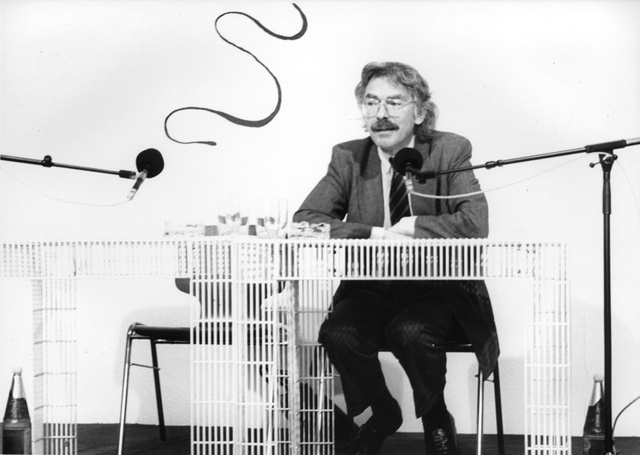 Friedrich Kittler, Graz, 1989
Friedrich Kittler, Graz, 1989
This thinking on infrastructural topologies (or the infrastructural production and maintenance of inside/outside) derives from my work on corporate architecture, which linked the discoveries of cybernetics to a topological, figure/ground “pattern seeing” in architecture and the visual arts. But it also modifies that work, by emphasizing the logistical, procedural repetitions within which difference arises. In terms of a “media history of the social,” I have recently returned to the work of Jacques Donzelot, in his Foucauldian history of the family as a unit of governmentality, for which Gilles Deleuze wrote a preface titled “The Invention of the Social.” Donzelot locates the family within Foucault’s dispositifs, including the dispositif of sexuality and the practices of the social worker. I am not the first to propose that such an analysis be extended to the field of housing. But I am particularly interested in how a neo-Foucauldian analysis of what could be called the “techniques” of housing – including, today as in earlier times, the “technique” of inequality – might intersect with, but also modify, a more classically Marxian treatment of this same subject.
In this work, as in my work on other infrastructural systems like corporations, universities, or, at another level, cities (i.e., mediators), I aim to show power-knowledge as a dimension of capital rather than as an analytical alternative to it, reorganizing thought as well as action. The globalizing, neoliberal city, for example, is a component in a cognitive infrastructure as well as a material complex. The insights and tools of materialist media theory, including the “techniques” of cultural techniques, invite engagement with these domains. There is always a chance, however, that the theory that emerges from such engagements may be unrecognizable to those accustomed to its initial settings, its “protected mode."
Isabelle Graw
Texte Zur Kunst: As the founder, with Stefan Germer, of this journal, could you share your thoughts as to why this journal historically tended to avoid discussing “media” and has generally positioned itself against related lines of German media theory? For example, why, in the early-mid ’90s, might Pierre Bourdieu (with his notion of the “social field”) have felt like a more viable point of reference than, say, Niklas Luhmann (with his notion of “social systems”; the “software,” so to speak, to Friedrich Kittler’s “hardware”)? Or would you draw these distinctions differently?
Isabelle Graw: I don’t think I share your assessment that Texte zur Kunst avoided the question of “media” in its early years and even took a stand against German media theory. As I see it, we always sought to engage with a variety of media theories while questioning them – see the conversation with Niklas Luhmann about his distinction between medium and form (September 1991) or the interview with Friedrich Kittler about the technical prerequisites of art (June 1994). Perhaps the choice of the interview format in these instances is what gives you the sense that we wanted to distance ourselves – a conversation is a good way to discuss the limitations of a theory and raise doubts and questions. Still, I think we’ve consistently tried – and this also goes for our various house theorists, such as Pierre Bourdieu – not to join any theory bandwagon and to instead stake out our own position vis-à-vis the different discursive conjunctures. For a good example, take the “Apparate” issue (March 1996), our first media issue, if you will. Instead of operating with the fairly imprecise concept of the medium, we proposed the category of the apparatus, as it also allowed us to promote a “materialist discourse,” as we stated in the preface. Another advantage of the term “apparatus,” as we saw it at the time, was that it encompassed not only technological, but also social and ideological constructions; see, for instance, what Louis Althusser wrote about the “ideological apparatuses of the state."
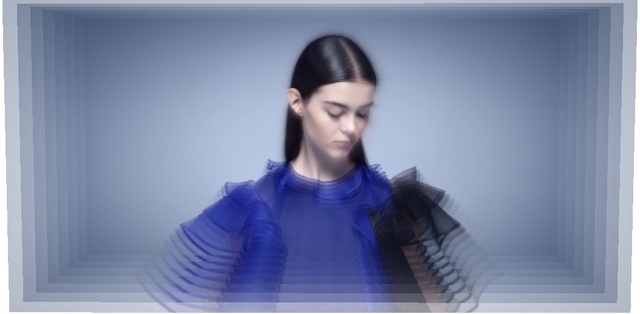
Still, we thought Kittler’s focus on the material conditions of production was interesting, and Luhmann’s systematic development of a relational conception of the medium was helpful. But Luhmann’s concept of autonomy makes it difficult for him to offer a meaningful theory of the increased significance of foreign reference (Fremdreferenz) in the art system; Kittler, meanwhile, posits one type of foreign reference as absolute: the programming of production by technologies. Both theories lack the social dimension, and in that regard they are conservative: just as Luhmann distances himself from any social theory that retains the analysis of structures of inequality and relations of power and insists on the possibility of change, Kittler, too, is interested solely in the impact of technological forces of production and blocks out the larger question of the relations of production.
TZK: From where you stand, what could be some of the problems posed by a return to ’90s media theory in 2015? And particularly, in Texte zur Kunst taking up the subject now?
Graw: One problem I see with returning to the media theory of the 1990s today is that we might end up ignoring the compelling objections to it that were raised even back then. Georg Stanitzek, for example, highlighted the concept’s persistent lack of precision and argued that media theory’s penchant for metaphors compensates for this vagueness. [3] Many of today’s Kittler enthusiasts overlook the unpleasantly sectarian vibes his followers in the 1990s, the “Kittler boys,” often gave off. But it’s also important to recognize what a provocation Kittler’s “Discourse Networks” was in the ’80s; it took real courage to write a book that so clearly departed from the academic standards of the time even in basic stylistic terms. Today, Kittler might certainly guide an exploration of what is often referred to as “post-Internet art” and the question of how the Internet, and social media in particular, program our subjectivities. Still, I would argue that a deeper understanding of the social dimension of these processes would require a perspective informed by a critique of economics as well as a theory of power, for which we are better off consulting sociologists and Michel Foucault. Social media such as Twitter, Instagram, and Facebook may be read as symptomatic of the operation of the “new economy” widely debated in the social sciences today, an economy that focuses the process of value creation on the subjects and capitalizes on their “life events” (Facebook). Foucault’s concept of biopower, moreover, can open our eyes to the genesis and operation of this technology of power, which, he writes, pervades our bodies and is “centered […] upon life.” [4] Now, media technologies have played a central part within this form of power aimed at life, especially since they facilitate and enforce the extraction and commercial exploitation of lived realities. But how do they do that and what does it mean when this value creation takes place in the form of data streams? To investigate these questions, we’d have to go beyond Kittler.
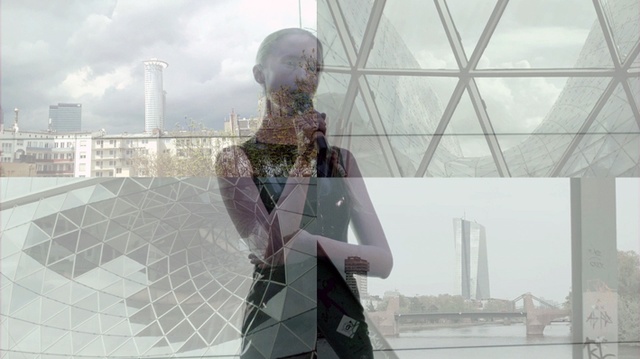 Britta Thie, "Transatlantics," 2015
Britta Thie, "Transatlantics," 2015
TZK: Texte zur Kunst has always understood art as contingent on the market, in both social and economic terms. Do you think it is possible to understand markets as media systems as well as social systems? Could a “media history of the social” extend certain Texte zur Kunst topoi?
Graw: In my book “High Price” (2008), I followed Lars Gertenbach in assuming that the market is a sort of network that spans the entire social realm. But any network has its holes, and so the metaphor isn’t meant to be totalizing. In other words, one can adopt a reflective stance vis-à-vis this networked market even if it’s impossible to completely disentangle oneself from it. Media, I would argue, are among the central agents governing this market, considering that we’ve lived in a media society at least since the late 1960s. But I wouldn’t draw a sharp distinction between media and social systems. The “social media” everyone talks about suggest – indeed, the very term spells it out – that social and media systems interlock closely, especially in digital culture. I also don’t think it would make much sense to give preference to a “media history of the social” over the sort of “social history of media” that has been characteristic of Texte zur Kunst: with a media history of the social, we would again run the risk of assigning a determinative role to the technological apparatus, blinding ourselves to all other social factors. If anything, a “media history of the social” would need to work with a conception of media wherein the term comprehends not just the “concrete reality of the apparatuses,” but also the “spectrum of different cultural techniques.” [5] But once you conceive of media as cultural techniques, the distinction between media history and social history grows blurry anyway. And a media history-as-social history is obviously something I would very much welcome.
Translation: Gerrit Jackson
André Rottmann
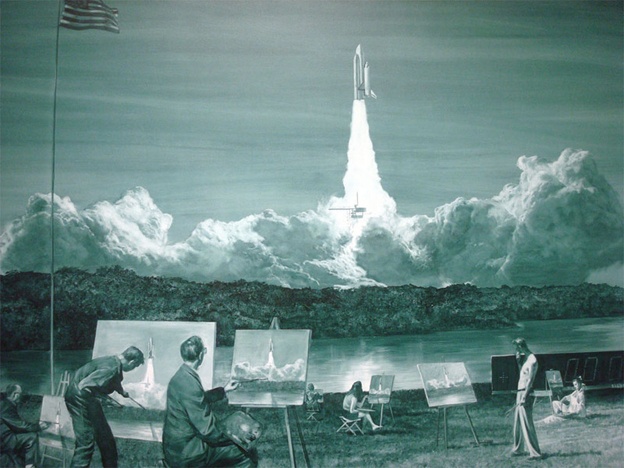 Mark Tansey, "Action Painting II," 1984
Mark Tansey, "Action Painting II," 1984
Texte zur Kunst: The reception of Friedrich Kittler and his students in Germany is complicated, compelling many in the academy in the 1990s and ’00s to take sides, especially those that study and teach art history. As Kittler did not directly write about art, and his engagements with visual media are famously problematic, could you say what it was about his work that felt possibly relevant to art-historical discussions and what, in turn, was at the crux of why it was largely rejected by art historians in Germany?
André Rottmann: Friedrich Kittler’s writings did indeed prompt aggressive rejection throughout the humanities. And yet they meanwhile garnered loyal, subservient admiration and emulation from an (almost entirely male) group of disciples. Though this antagonism is tied to an era now long passed, it may have been precisely why a broader dissemination of Kittler’s theoretical proposals did not happen right away – the author’s own penchant for bleak prose, associative argumentation, apodictic assertions, and political provocation notwithstanding. However, the unprecedented amalgamation of discourse analysis, Lacanian psychoanalysis, Nietzschean genealogy, and Heideggerian Seinsgeschichte that Kittler cohered (and then utilized to dismantle the tenets of aesthetic ideology and hermeneutic tradition) did provide the foundation for an entire field of research (i.e., media studies). More importantly, it in crucial ways contributed to a new episteme: by building on yet also surpassing the methodology proposed by his idol Michel Foucault, Kittler engaged with modern culture in view of the hardware, storage, transmission, and processing of flows of data (beyond the realm of the purely textual). In doing so he likewise surpassed the grammatology of his interlocutor Jacques Derrida, understanding writing not only in terms of its différance, but as an information technology increasingly commanding the laws to which humans are mercilessly submitted. [6] Scholars in the humanities soon began to trace the emergence of aesthetic achievements as well as scientific discoveries and subject formations through a “Matrix of Materialities,” i.e., the factual entanglements among knowledge, devices, bodies, and political economies; the success of this approach, once fiercely contested, has become so pervasive in the meantime that it is hardly recognized anymore. [7]
Kittler’s work – ranging from his studies, in the 1980s, on Romantic literature’s hidden educational apparatus and the analysis of modernity’s passage from the hallucinatory experience of silent reading to the modulation of the senses through media to, in the ’90s, a focus on computerization and finally, in his last decade, Greek antiquity – soon ceased to be the stuff of shock and scandal, entering the pages of textbooks as a classic of postwar theory during his lifetime. [8] As I write this, in fact, 26 volumes of his collected writings are being prepared for publication, and a recent anthology goes as far as to promise “Current Perspectives in Kittler Studies.” [9] Canonization seems completed.
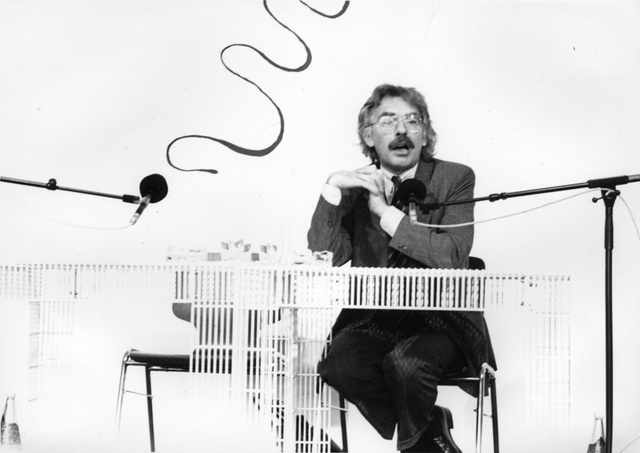 Friedrich Kittler, Graz, 1989
Friedrich Kittler, Graz, 1989
At this point, even the most “problematic” strands of Kittler’s thought now appear as valuable historical indices of his intellectual biography and academic milieu. In this sense, the media scholar Claus Pias, in the recent April issue of Merkur, for example, pleads for a contextualizing approach to Kittler’s legacy, arguing against its ongoing veneration (or condemnation, for that matter). Specifically, Pias questions the relevance of the infamous idea that all civilian communication is based on a “misuse of military equipment” – an idea that epitomizes the techno-determinism for which Kittler’s work has often been rightfully reproached. Pias locates the emergence of this notion in an earlier era of computerization and hacker culture, one organized around discrete apparati, which must be distinguished from the monolithic interconnected services that organize our present and that do not lend themselves to comparable modes of misuse. [10] In other words, Kittler’s prediction that a general digitalization of information and channels would erase the difference between individual media by now undermines one of the apriori of his very own theoretical agenda: hardware alone, if it ever did, does not suffice to account for the capacity of contemporary media networks to absorb and create value from human resources.
Nevertheless, historicization does not equal obsolescence. Kittler’s theoretical contributions remain crucial to any debate of our media-saturated and technologically-inclined present because of the rigor and depth of his analysis – despite the disturbing fact that his apocalyptic rhetoric and penchant for the politically incorrect (which meanwhile aligns his writing with that of Paul Virilo, Jean Baudrillard, and other exponents of poststructuralist anti-humanism) happens to often revel in the marvels of German engineering during World War II. In other words, I would argue for a dialectical reconsideration of Kittler’s work that assesses its current pertinence precisely through the recognition of its historical limitations, innate shortcomings, and political confusions.
With hindsight, artistic production can certainly be a primary touchstone for such a critical reevaluation, because the realm of the aesthetic – or more precisely, the idealism and values traditionally subtending it – were at the center of Kittlerian dismissals, displaying a tremendous ignorance (or disregard) for the complicated history of its contestation, deskilling, and desublimation since the 1960s. [11] Therefore it is no surprise that despite the fact that his writings were, early on, published in October and later in Grey Room (and occasionally reviewed and debated in Texte zur Kunst), art-historical considerations or even collaborations are still scarce. [12] But the fact that Kittler himself had little to no interest in contemporary art and only sporadically wrote on so-called Medienkunst, or on the standardization inflicted by computer-aided architecture, hardly speaks against the potential relevance of his writing for art history and criticism – after all, neither do the texts by Derrida on Peter Eisenman or Alain Badiou on Mark Lombardi really offer convincing interpretations. Against current claims about the exhaustion of theory and its complacent delegation to the history of ideas, Kittler should simply be regarded as another theoretical thinker whose concepts can inform art history without the need to discard the discipline’s entire discursive scaffolding – at a time when criticism, evidently, is struggling to come to terms with the impact of media on the production and dissemination of art.
 Commodore Amiga 1000 (with monitor), 1985
Commodore Amiga 1000 (with monitor), 1985
TZK: Texte zur Kunst has historically aligned itself with both Marxist sociology and Foucault’s theories of biopolitics while, with a few notable exceptions, we have largely sidestepped the questions of media posed by Kittler’s work. Having served as the journal’s editor-in-chief from 2006 to 2010, why in your opinion was this separation maintained? What could the problems be in coming back to the discourse now? Conversely, what might it offer?
Rottmann: In terms of a dialectical approach to Kittler’s work – one that would seek to reposition it by going beyond its impasses – it is truly important to recall that, as the ’90s progressed, he grew increasingly emphatic that the hardware of media should be taken as the sole basis of modern history, culture, and society. With this, he relentlessly articulated his disdain for Frankfurt School critical theory and the discipline of sociology as a whole, expelling exactly those interests, methods, and concerns that were foundational for a journal like Texte zur Kunst: social art history and its attention to the economic and political frameworks of the aesthetic; cultural studies and its insistence on alternative models of subjectivity and community provided by Pop; Pierre Bourdieu’s analysis of taste and distinction; as well as feminism, queer studies, and the actuality of so-called “Institutional Critique.” No wonder then that points of convergence and connection were rare. Texte zur Kunst’s turn, in recent years, toward questions of biopolitics and the related intertwinement of contemporary art and project-based economies certainly did not bridge this distance. The analysis of these developments – as explored in this journal in, for example, issues such as “After the Crisis” (2009) and “Life at Work” (2010) – demanded a focus on economic shifts (and their artistic consequences and contestation) rather than a consideration of the predominance of media.
With hindsight, the constitutive role media devices and services play in terms of cognitive labor and the entrepreneurial self of late capitalism (as evidenced by the rise of platforms such as Instagram as a primary image source in Texte zur Kunst’s more recent issues) surely was not sufficiently addressed (or foreseen). The disintegration of the monolithic culture industry into interconnected media networks in the meantime generated a new attention economy for contemporary art that entails the promise of greater accessibility, heightened visibility, and increased participation, as well as the danger of anomic dispersal, enforced fragmentation, and discursive vacuity. Against this backdrop, Kittler’s programmatic contention from 1992 that “there is no software” only underlines Pias’s appeal for a historicization of some of the former’s stances. Yet media theory of the Kittlerian persuasion and a reflection on “control societies” (as analyzed by Gilles Deleuze in his famous “Postscript”) generally are not mutually exclusive; quite to the contrary, the notion of control – that operates across decentered networks – and that of the Aufschreibesystem, which Kittler defined as the “network of techniques and institutions that allow a given culture to select, store and process relevant data,” have to be regarded as highly compatible and thus equally productive as frameworks for thinking about art in an age that Rosalind Krauss has characterized by its “post-medium condition.” [13]
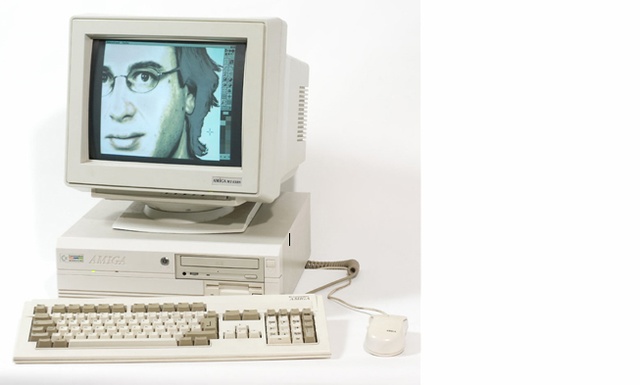 Commodore Amiga 4000/40 (with monitor); software: Deluxe Paint V, 1992
Commodore Amiga 4000/40 (with monitor); software: Deluxe Paint V, 1992
Ultimately, this confrontation concerns the status of art itself. Evidently, artistic practices cannot be fully integrated into the history of optical or any other media. The increasingly precarious promise of artistic production, its epistemic and critical potential, cannot be sublated and determined by the historical effects of media technologies. There is no Kittlerian art history. However, there is the challenge to think about the degree to which a consideration of the network of techniques and institutions that allow a given culture to select, store, and process relevant data might coalesce with an analysis, as put forward by Benjamin Buchloh, of “the institutions, which determine the conditions of cultural consumption [...] [and] in which artistic production is transformed into a tool of ideological control.” [14] Such a line of inquiry could open up new avenues for the study of twentieth-century art (which at various turns can be characterized by the use of such inconspicuous media and devices as index cards, typewriters, typography, photographic records, plaques, and postal systems). The task, then, is to keep media theory and contemporary art history in tandem, i.e., to neither ignore the impact of technology on the aesthetic in order to restitute traditional notions of autonomy (or marvel at the outmoded and obsolete), nor to completely dissolve artworks into the networks of circuits of communication at the cost of their ancestral critical potential.
As Simon Baier has argued in Texte zur Kunst, recent art-historical engagements with the new velocity and intensity of communication and circulation – though urgently needed and following plausible impulses – tend toward the latter. [15] Metaphors and idioms stemming from the realm of social media and digital technology, rather than the palpable material structures supporting them, frequently serve as points of departure for argumentation, or mere speculation. Kittler’s work in this respect can function as a reminder of the validity of the opposite approach: to identify and gauge the palpable impact of computerization (despite technology’s tendency to conceal its essence) while avoiding any such aestheticization of media.
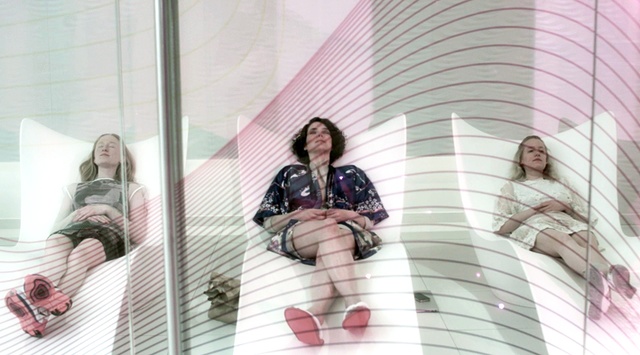 Britta Thie, "Transatlantics," 2015
Britta Thie, "Transatlantics," 2015
TZK: The concept of “cultural techniques,” as developed by Cornelia Vismann (†) and Bernhard Siegert, has been central to a recent expansion of the definition of “media.” Rather than merely discrete technological objects, media are, instead, being increasingly defined as operations. How could such a concept be used productively for understanding certain art practices? Do you feel that the operations of the art “institution” can be described in these terms?
Rottmann: The concept of “cultural techniques,” originally stemming from early twentieth-century treatises on agriculture, appears only sporadically in Kittler’s œuvre. It is arguably, however, the central idea around which German media theory has been reoriented. Though a still much-debated notion said to mark the transition from anti- to post-humanism, it nonetheless can be seen as encompassing ideas and implications that in their entirety serve as correctives to the exclusionary tendencies of techno-determinism. As Bernhard Siegert has elucidated, cultural techniques – the most elementary arguably being writing, counting, and drawing – generally designate operative chains that come before the alphabet, number, or the concept of the image, yet already depend on a historically given “micro-network” of technologies and techniques. [16] They generate media through practices and processes and as such allow one to think anew about the various formats and variegated materials integrated into the morphology of artworks since the avant-gardes – which is to say, beyond already established categories of appropriation, quotation, and simulation. Other than Kittler’s approach, which famously denounced Marshall McLuhan’s dictum that media are extensions of man, cultural techniques (in this respect at least) imply a corporeal and bodily dimension that might and should be extended to include considerations of gender and ethnicity so far glaringly absent from so-called German media theory. [17]
The most basic act cultural techniques perform is to draw those distinctions that by introducing difference – such as the one gates generate between the inside and outside, or a plow between land and property [18] – lead to acculturation in the first degree. Siegert emphasizes that as assemblies of substitutions and symbols, cultural techniques on the one hand produce and institute the interface between the cultural order and the real, yet on the other hand harbor the potential to interrupt and disturb this very order by exposing the unmarked space that is presupposed and excluded by its instigation – hence cultural techniques imply the possibility of making tangible those elements that are excluded in all forms of institutionalization, intrinsically connecting them to an analytics of power. [19]
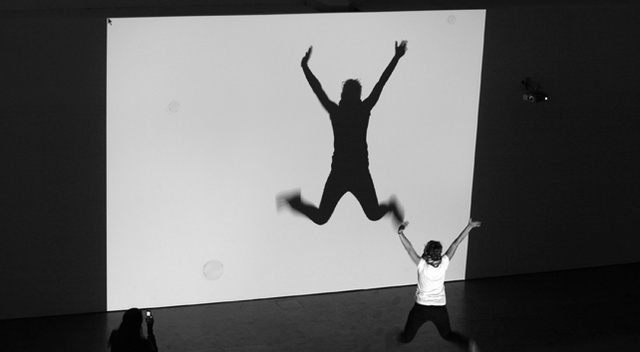 Wolfgang Münch, Kiyoshi Furukawa, "Bubbles," ZKM Karlsruhe, 2000, installation view
Wolfgang Münch, Kiyoshi Furukawa, "Bubbles," ZKM Karlsruhe, 2000, installation view
Notes
| [1] | Britta Thie, “Transatlantics,“ 2015, film still |
| [2] | christopherkane.com, 2015 |
| [3] | Georg Stanitzek, “Im Medium der Medientheorie. Figuren der Eigentlchkeit/Kulturkritik,” in: Texte zur Kunst, 21, 1996, pp. 32–39. |
| [4] | See Michel Foucault, Society Must Be Defended, trans. David Macey, London 2003, "eleven: 17 March 1976," p. 249. |
| [5] | See Stefan Rieger, Die Individualität der Medien. Eine Geschichte der Wissenschaften vom Menschen, Frankfurt/M. 2000, p. 16f. |
| [6] | See Friedrich A. Kittler, Gramophone, Film, Typewriter, Stanford 1999, p. xli. |
| [7] | I borrow the term “A Matrix of Materialities” from a recent essay on “Seurat’s Media” by Carol Armstrong in: Grey Room, 58, pp. 6–25. On the implicitness of Kittler’s foray into today’s humanities see Peter Geimer’s obituary for Friedrich Kittler, in: Texte zur Kunst, 84, 2011, pp. 207–209, here: p. 208. |
| [8] | Geoffrey Winthrop-Young’s introduction on Kittler’s work, “Friedrich Kittler zur Einführung” (Hamburg 2005), later published in English as “Kittler and the Media” (Cambridge/Malden 2015), is both instructive and a symptom of this process. |
| [9] | Stephen Sale/Laura Salisbury (eds.), Kittler Now: Current Perspectives in Kittler Studies, Cambridge/Malden 2015. |
| [10] | See Claus Pias, “Friedrich Kittler und der ‘Mißbrauch von Heeresgerät’. Zur Situation eines Denkbildes 1964 – 1984 – 2014,” in: Merkur, 791, pp. 31–44, p. 33f. Pias’ argument mainly regards Kittler’s 1988 essay “Rock Music: A Misuse of Military Equipment,” in: Hans Ulrich Gumbrecht (ed.), Friedrich A. Kittler, The Truth of the Technological World: Essays on the Genealogy of Presence, transl. by Erik Butler, Stanford 2013, pp. 152–164. |
| [11] | For a cogent consideration of the pressures currently exerted by the forces of desublimation see Benjamin H. D. Buchloh’s introduction to his “Formalism and Historicity: Models and Methods in Twentieth-Century Art,” Cambridge/London 2015, in particular pp. xxii-xxvi. |
| [12] | I am thinking here of Horst Bredekamp’s collaborations and exchanges with Kittler since their arrival at the Humboldt University of Berlin, for example in research projects such as “Bild Schrift Zahl” at the Hermann von Helmholtz-Zentrum für Kulturtechnik; Peter Geimer’s history of photographic accidents departs from the medium’s material inscriptions of the real and thus seems partly predicated on a Kittlerian analysis of hardware without human agents. See for instance Peter Geimer, “A Self-Portrait of Christ or the White Noise of Photography? Paul Vignon and the Earliest Photograph of the Shroud of Turin,” in: Grey Room, 59, 2015, pp. 6–43. Recently, Rosalind Krauss has further elucidated her defense of medium-specificity and its mnemonic dimensions vis-à-vis Kittler’s above evoked contention that all distinctions between media become obsolete under the conditions of digitalization in: “Under Blue Cup,” Cambridge/London 2011, pp. 38f. |
| [13] | Gilles Deleuze, “Postscript on the Societies of Control,” in: October, 59, pp. 3–7; the definition of the Aufschreibesystem is to be found in: Friedrich A. Kittler, Discourse Networks 1800/1900, Stanford 1992, p. 369; on the notion of the post-medium condition see Rosalind E. Krauss, A Voyage on the North Sea: Art in the Age of the Post-Medium Condition, London 2000; on the relation between these positions see my “Networks, Techniques, Institutions: Art History in Open Circuits,” in: Texte zur Kunst, 81, 2011, pp. 142–144. |
| [14] | Benjamin H. D. Buchloh, “Conceptual Art 1962–1969: From the Aesthetics of Administration to the Critique of Institutions” [1990], in: Benjamin H. D. Buchloh, “Formalism and Historicity,” Cambridge/London 2015, p. 464. For a first attempt to follow such a line of inquiry see my “Displacing the Site: John Knight and the Museum as Modulation” [2011], in: John Knight: October Files, ed. André Rottmann, Cambridge/London 2014, pp. 177–197. |
| [15] | See Simon Baier, “Das Feste und das Flüssige. Über ‘After Art’ von David Joselit,” in: Texte zur Kunst, 90, 2013, pp. 188–193, p. 192. |
| [16] | Bernhard Siegert, “Cultural Techniques: Or the End of the Intellectual Postwar Era in German Media Theory,” in: Theory, Culture & Society, Vol. 30, No. 6, 2013, pp. 48–65, p. 58. |
| [17] | See Bernhard Siegert, “Cacography or Communication? Cultural Techniques in German Media Studies,” in: Grey Room, 29, 2007, pp. 26–47, p. 30. |
| [18] | See Cornelia Vismann, “Kulturtechniken und Souvernität,” in: Zeitschrift für Medien- und Kulturforschung, 1, 2010, pp. 171–181, here: p. 171. |
| [19] | See Bernhard Siegert, “Cultural Techniques,” p. 61f. Also see Siegert, “Cacography or Communication?,” p. 31. |
| [20] | Bernhard Siegert, “Doors: On the Materiality of the Symbolic,” in: Grey Room, 47, 2012, pp. 6–23. |

